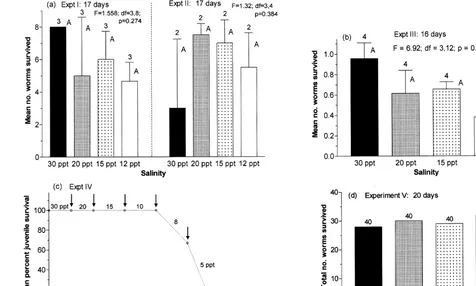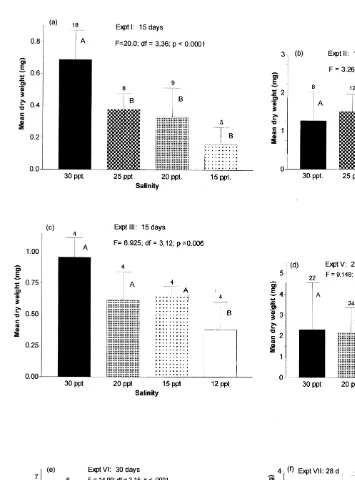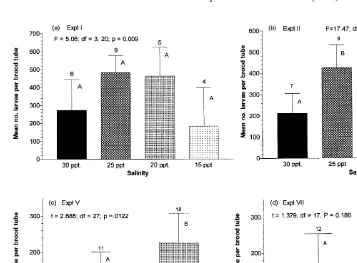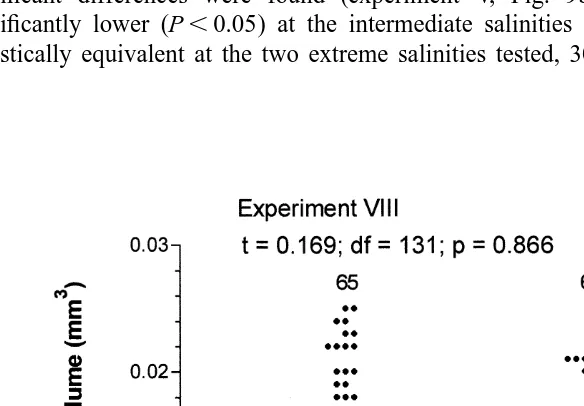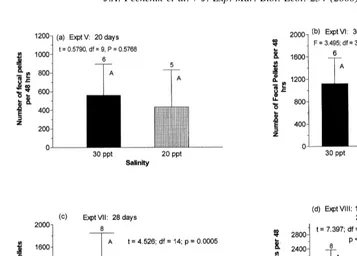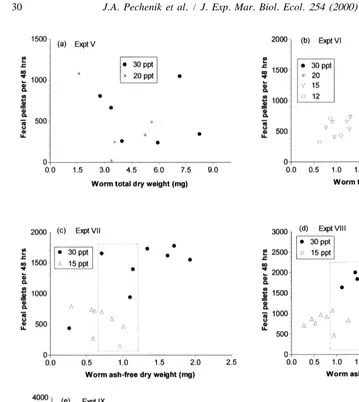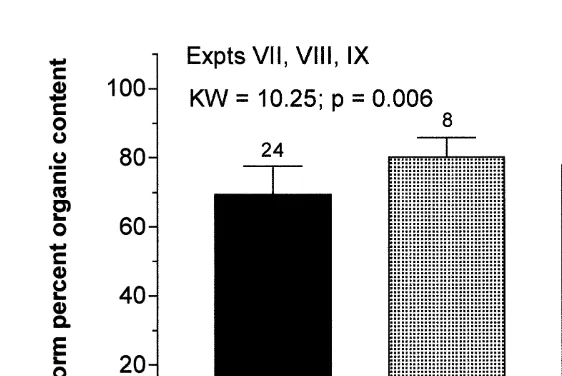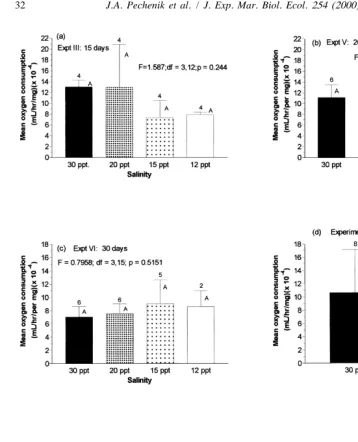Journal of Experimental Marine Biology and Ecology 254 (2000) 19–35
www.elsevier.nl / locate / jembe
Effects of reduced salinity on survival, growth, reproductive
success, and energetics of the euryhaline polychaete
Capitella sp. I
*
Jan A. Pechenik , Richelle Berard, Lisa Kerr
Biology Department, Tufts University, Medford, MA 02155, USA
Received 17 August 1999; received in revised form 25 October 1999; accepted 11 July 2000
Abstract
Physiological adjustment to water of reduced salinity requires energy expenditure. In this study we sought to determine the fitness costs associated with such adjustment in the euryhaline polychaete Capitella sp. I, and the extent to which such costs could be explained by increased rates of energy expenditure. In a series of experiments conducted at 208C, salinity was reduced from 30‰ to either 25, 20, 15, 12, or 10‰ within 72 h after the larvae had been induced to metamorphose. Juveniles were reared on fine, organic-rich sediment. Over the next 15–30 days, we determined survival, growth, fecundity, and rates of respiration and feeding (via fecal pellet production). Larval salinity tolerance was also determined. Juvenile survival at salinities as low as 12–15‰ was comparable to that at 30‰. The lower limit of salinity tolerance was 10–12‰ at 208C for both larvae and juveniles. Juveniles grew significantly more slowly at 12–15‰ in six of the seven experiments. Fecundity, however, was generally highest at intermediate salinities of 20–25‰, and comparable at 30 and 15‰. No individuals released embryos at 12‰ over the approximately 30-day observation periods in any of the three experiments in which the worms were reared at this low salinity. Reduced growth rates were not explained by differences in rates of respiration at different salinities: at reduced salinity, respiration rates were either statistically equivalent to (P.0.10) or significantly below (P,0.05) those recorded for animals maintained at 30‰. Lower growth rates at lower salinities were best explained by reduced feeding rates. Further studies are required to determine whether digestive efficiency, growth hormone concentrations, or reproductive hormone concentrations are also altered by low salinity in this species. 2000 Elsevier Science B.V. All rights reserved.
Keywords: Capitella; Polychaete; Salinity; Growth; Reproduction
*Corresponding author. Tel.: 11-617-627-3192; fax: 11-617-627-3805. E-mail address: [email protected] (J.A. Pechenik).
1. Introduction
Euryhaline animals cope with fluctuating salinity either through morphological and behavioral mechanisms that enable them to avoid exposure to the osmotic stress or through physiological mechanisms (osmoregulation, volume regulation) that enable them to maintain constant cell and body volume (Kinne, 1971; Withers, 1992). However, even with these physiological mechanisms most euryhaline animals are not immune from the effects of salinity change; documented sublethal effects of altered salinity include reduced rates of growth and development (e.g., Tietjen and Lee, 1972; Lambert et al., 1994; Qiu and Qian, 1997; Anger et al., 1998; Rosas et al., 1999; Specker et al., 1999) and reduced fecundity (e.g., Morritt and Stevenson, 1993; Cheung, 1997; older literature reviewed by Kinne, 1971; Remane and Schlieper, 1971). The proximate causes of such effects on growth and reproduction have been little studied among marine invertebrates. Documented sublethal effects may reflect the energetic costs of coping with salinity stress: under conditions requiring increased osmoregulatory or volume regulatory work, less energy may be available for growth and reproduction (e.g., Lankford and Targett, 1994; Woo et al., 1997). However, such effects may also reflect decreased rates of energy intake (feeding), increased activity levels, decreased efficiency of digestion or assimilation, or altered concentrations of growth and reproductive hormones (e.g., Kinne, 1971; Febry and Lutz, 1987; Lambert et al., 1994; Woo et al., 1997; Brown and Terwilliger, 1999). To date, relevant studies have been primarily conducted using marine fishes; few studies have considered these factors for marine invertebrates, and even fewer have considered the effects over the entire life cycle. In this study we sought to document the effects of lowered salinity on the survival, growth, and reproductive output of the euryhaline, deposit-feeding polychaete Capitella sp. I, and to determine the extent to which the effects could be explained by changes in individual respiration or feeding rates. The effects of diet, sediment organic content, pollutants, and prolonged larval life on growth and life history characteristics have been well documented for this and other capitellid species (e.g., Pechenik and Cerulli, 1991; Qian and Chia, 1992a,b; Bridges, 1996; Levin et al., 1996; Cohen and Pechenik, 1999). Salinity effects, however, have not been reported previously.
2. Materials and methods
2.1. Maintaining adults and obtaining larvae
J.A. Pechenik et al. / J. Exp. Mar. Biol. Ecol. 254 (2000) 19 –35 21 maintained in clean glass dishes in the absence of sediment to discourage metamorphosis (Pechenik and Cerulli, 1991).
2.2. General experimental conditions
All experiments were conducted at 208C with a photoperiod of 12L:12D, and generally included larvae pooled from at least two females. All seawater was collected from Nahant, MA, USA and forced through a 0.45-mm filter cartridge (Gelman Sciences, Ann Arbor, Michigan) and well-aerated before use. Dilutions were made by adding an appropriate volume of dionized water, and salinities were assessed using a refractometer. All experiments with the same numerical designation were conducted using worms from the same batch of larvae.
Not all parameters were measured in all experiments (Table 1). In some cases additional parameters were added after seeing the results of the first few experiments. In other cases some experiments had to be terminated before enough individuals reached reproductive maturity, so that fecundity could not be determined in all treatments.
2.3. Determining larval and juvenile salinity tolerance
Larvae from three broods were combined in a glass dish of 30‰ filtered seawater. Twenty-four hours later, ten larvae were placed in each of four small (6-cm diameter) glass dishes containing 10 ml of well-aerated seawater at each of the following salinities: 30, 20, 15, 12, or 10‰. The dishes were stacked on top of each other to deter evaporation. Larval activity and survival were assessed 48 h later. Spot checks showed that salinity did not change over the 48-h period.
To determine the salinity tolerance of juveniles, eight (three experiments) or ten (two experiments) larvae were transferred into each of 12 dishes (8-cm diameter) containing 60 ml of well-aerated seawater at 30‰. One gram of sediment was then added to each dish to induce metamorphosis (Pechenik and Cerulli, 1991). Three days later, most of the seawater was removed by pipette and replaced with 50 ml of seawater of reduced salinity (covering the range 10–30‰). One additional gram of sediment was added to
Table 1
a
Summary of data on the effects of salinity on growth, reproduction, and energy expenditure of Capitella sp. I Exp. Growth rates Fecundity Feeding rates Respiration rates Days to brood tube production
each dish. Two days later the water was again replaced with aerated seawater of appropriate salinity, and another 1 g of sediment was added as food for the growing animals. Three replicates were established per treatment in two experiments, while a third experiment was conducted without replication. Survival was assessed 16–30 days after the initial reduction in salinity.
In one additional experiment, 60 juvenile worms, maintained for about 2 weeks at 30‰ salinity, were distributed among ten large glass dishes (10.5-cm diameter) containing 100 ml of seawater and 7 g of sediment. None of the worms had developed conspicuous gonads by the start of the experiment. In five of the ten dishes, salinity was lowered every 5 days according to the following scheme: 30‰→20‰→15‰→ 10‰→8‰→5‰. A control group of worms (five dishes with six worms each) was maintained at 30‰, with the seawater changed every 5 days to ensure equal handling and oxygen availability. The number of surviving worms was counted in all dishes prior to each water change.
2.4. Determining effects of salinity on juvenile growth rate
Eight experiments were conducted. In each experiment, 15–30 days after the salinity exposures were initiated, 15–20 worms were retrieved from each treatment, rinsed free of mud and fecal material, and rinsed briefly in deionized water to remove adhering salts. The worms were then transferred to preweighed aluminum foil pans and dried for 48 h at 558C. The pans were then weighed to the nearest 0.01 mg using a Cahn Model 51 electrobalance, with desiccant in the weighing chamber to prevent specimen rehydration. In one of the experiments each pan contained two worms, while the worms were weighed individually in the other experiments. Each experiment included at least three replicates per treatment.
2.5. Effects of salinity on fecundity
Four experiments were conducted. Larvae from several broods were combined and then distributed among the salinity treatments, induced to metamorphose, and then raised at the test salinity in batch culture to reproductive maturity (four replicates per treatment). Water was replaced with water of appropriate salinity once each week, and freshly aerated mud was added periodically to ensure excess food availability. For each experiment, 4–18 brooding females from each salinity treatment were eventually transferred to individual glass dishes of seawater at the same salinity. The dishes were then monitored daily for larval release, and the number of larvae produced by each female was determined.
2.6. Effects of salinity on rates of fecal pellet production
J.A. Pechenik et al. / J. Exp. Mar. Biol. Ecol. 254 (2000) 19 –35 23 48 h and stored in seawater for several days to allow for the degradation of mucus binding the pellets together. In one experiment we measured at 403 the length and width of a random sampling of approximately 65 fecal pellets from the 30 and 15‰ treatments to determine whether animals feeding at different salinities produced fecal pellets of comparable size. After the feeding period ended, respiration rates were determined for the same individuals, as discussed in the next section, and the animals were weighed as described previously so that fecal production rates could be examined as a function of body weight. In three of the experiments, the weighed pans were transferred to a muffle furnace at 5008C for 5 h and then reweighed to determine the ash-free dry weight and percent organic content. This enabled us to determine whether the percent organic content was comparable in worms raised at different salinities.
2.7. Effects of salinity on respiration rate
Six experiments were conducted. At least 15 days after the salinity treatments were initiated, twelve worms were removed at random from dishes at each salinity. Worms were gently cleaned of debris and placed in pairs into small glass bottles each containing approximately 5 ml of well-oxygenated seawater of appropriate salinity that had just been poured into the bottles from a common container. With one exception (due to particularly poor worm survival at one low salinity), each experiment included at least four replicates per treatment. The worms in each pair were similar in size. A glass bead was added to each bottle, which was then sealed with Parafilm and incubated at 208C for 2–3 h. Less than 30 s elapsed between adding the worms and sealing the bottles. The glass beads allowed the water to be well-mixed before samples were removed for oxygen determinations. Three control bottles were prepared per treatment, containing fully oxygenated seawater of the appropriate salinity but no worms, for determination of background respiration. Samples of approximately 1.0 ml were removed from each bottle (after mixing) and the oxygen concentration was determined using a Strathkelvin Instruments (Glasgow, Scotland) Model 1302 electrode coupled to their Model 781 oxygen meter. Oxygen concentrations showed no change during incubation in the control bottles. Respiration was determined as ml of O consumed per mg of total body2 weight per hour.
2.8. Data analysis
3. Results
3.1. Larval and juvenile survival
Larvae of Capitella sp. I tolerated a wide range of salinities in the 48-h study: all larvae survived at even the lowest salinities tested, 10 and 12‰. However, the larvae were pale and moved only sluggishly at 12‰, and were pale and inactive at 10‰. At both 10 and 12‰ larvae showed dramatically smaller yolk reserves by the end of 48 h. Juveniles also tolerated a wide range of salinities (Fig. 1). Survival was statistically equivalent at all salinities (P.0.10) in two long-term experiments (experiments I and II, 17 days) and appears to have been comparable at all salinities in a fourth experiment in which survival among replicates was not recorded (experiment V, Fig. 1d). Only in experiment III (16 days) was survival significantly lower at 12‰, but note that survival was abnormally poor in all treatments in that experiment. The poor survival in all treatments of this experiment probably reflects inadequate oxygenation of the sediment before it was added to the culture dishes; high concentrations of H S are toxic to these2 worms (Dubilier, 1988). No worms survived to reproductive maturity at 10‰ in any experiment. In experiment IV, 100% of the juvenile worms survived gradually declining salinities for 25 days, until the salinity was reduced from 10 to 8‰ (Fig. 1c); no control worms died when held at 30‰ for the entire 36 days. In a preliminary experiment, no juvenile worms were alive 48 h after being transferred directly from 30 to 10‰, while no control worms died during that time.
3.2. Juvenile growth rates
Although long-term juvenile survival was generally high at salinities down to about 12‰, growth rates were usually reduced at the lower salinities (Fig. 2). Growth was significantly reduced (P,0.05, relative to that at 30‰) at 12‰ in all three experiments (experiments III, V, and VI), and at 15‰ in five of the seven experiments that included that test salinity (experiments I, V, VI, VII, and VIII). The growth rates were significantly reduced at 20‰ in only one (experiment I) of the six experiments that included that salinity.
3.3. Reproductive activity and fecundity
J.
A
.
Pechenik
et
al
.
/
J.
Exp
.
Mar
.
Biol
.
Ecol
.
254
(2000
)
19
–
35
25
J.A. Pechenik et al. / J. Exp. Mar. Biol. Ecol. 254 (2000) 19 –35 27
Fig. 3. Influence of salinity on mean fecundity (1one S.D.) of Capitella sp. I. The number above each bar indicates the number of brood tubes releasing larvae in each treatment.
3.4. Feeding rates and organic content
Fecal pellet volumes were not significantly different (t50.169, df5131, P50.866) for worms feeding at 15 and 30‰ (Fig. 5), so that rate of pellet production should accurately reflect feeding rates regardless of salinity. As reflected by rates of fecal pellet production, feeding rates were significantly reduced (P,0.05) below salinities of 20‰ (Fig. 6). In three of the five experiments (experiments VI, VII, and VIII) worms feeding in the different treatments were significantly smaller (P,0.05) at the lower salinities (Fig. 7). However, even in those experiments the rates of fecal pellet production were always lower at salinities below 20‰ in the regions at which body weights overlapped (Fig. 7c and d).
Worms reared at 30‰ were significantly lower in percent organic content (P,0.05) than those reared at lower salinities (Fig. 8).
3.5. Respiration rates
Mean weight-specific respiration rates were statistically comparable at all salinities in five of the six experiments conducted (Fig. 9). In the one experiment in which significant differences were found (experiment V, Fig. 9b), respiration rates were significantly lower (P,0.05) at the intermediate salinities tested (15 and 20‰) and statistically equivalent at the two extreme salinities tested, 30 and 12‰.
J.A. Pechenik et al. / J. Exp. Mar. Biol. Ecol. 254 (2000) 19 –35 29
Fig. 6. Influence of salinity on rates of fecal pellet production by juvenile Capitella sp. I. The number of individuals feeding in each treatment is indicated above the bars; adjacent capital letters indicate whether or not means differ significantly from control (30‰) means. The age of the worms tested is indicated for each experiment.
4. Discussion
Fig. 7. Relationship between fecal pellet production and individual (or ash-free) dry weight of the Capitella sp. I worms producing them. Each point represents data from a single individual. The dotted rectangle in (c) and (d) indicate regions in which worm dry weight overlapped in the two salinity treatments.
J.A. Pechenik et al. / J. Exp. Mar. Biol. Ecol. 254 (2000) 19 –35 31
Fig. 8. Percent organic content of worms (Capitella sp. I) feeding at three different salinities. Data are pooled from three experiments (experiments VII, VIII, and IX). Numbers above each bar indicate the number of worms in each treatment group. * Along x-axis indicates means that are significantly higher than the control (30‰) mean.
(e.g., Hawkins and Hilbish, 1992; Withers, 1992), so it is not surprising that we found reduced rates of growth, delayed reproductive activity, and lower fecundities at lower salinities; however, these are not foregone conclusions. Salinity over a wide range had no significant impact on developmental time or fecundity in two estuarine nematode species (Moens and Vincx, 2000a).
Although growth rates were affected by salinity in most of our experiments, the differences in mean growth rates were not explained by the differences in rates of energy expenditure. In experiment VI, for example, growth rates were significantly lower for worms raised at 12‰ but there were no significant differences in mean respiration rates at any of the salinities tested (Table 1). Similarly, in experiments VII and VIII, worms grew significantly faster (P,0.05) at 30‰ than at 15‰, but mean respiration rates at these two salinities were statistically equivalent (Table 1). Thus, the dramatically lower growth rates recorded at lower salinities were apparently not due to the energetic costs associated with physiological adjustment to low salinity.
Fig. 9. Influence of salinity on mean rates (1one S.D.) of oxygen consumption by juvenile worms(Capitella sp. I). These experiments were conducted just after feeding rate determinations were made and just before dry weights and ash-free dry weights were determined on the same individuals. Numbers above each bar indicate no. replicates per treatment. Means that do not differ significantly (P.0.10) from the control mean (30‰) share a common capital letter.
assimilation rates were significantly affected by salinity over a broad range (Moens and Vincx, 2000b).
J.A. Pechenik et al. / J. Exp. Mar. Biol. Ecol. 254 (2000) 19 –35 33 measured, the correspondence between these two traits was perfect: both mean growth rates and mean feeding rates were significantly reduced only at salinities of less than 20‰ (Table 1, experiments V–IX). We note that our feeding rate data are subject to some interpretative difficulties, in that in several experiments the worms tested at the lower salinities were smaller than those tested at the higher salinities. Thus, lower feeding rates at low salinities in some of the experiments could be due to the smaller mean size of the worms tested rather than to the direct effects of the lower salinity. However, this seems unlikely for two reasons. First, in experiments in which individual body weights of worms at different salinities overlapped (experiments VII and VIII), worms of equivalent size produced fewer fecal pellets at 15‰ than at 30‰ (Fig. 7c and d). In addition, mean percent organic content was significantly higher for worms raised at low salinities (20 and 15‰, Fig. 8), which can be readily explained by lower feeding rates at lower salinity: with lower feeding rates the digestive tract should contain less sediment, and thus less inorganic material, at any given time.
Although few studies have sought to document fitness costs associated with salinity stress in marine invertebrates, there is a substantial literature on the topic in the fisheries and fish mariculture literature (e.g., Febry and Lutz, 1987; Lambert et al., 1994; Lankford and Targett, 1994; Woo et al., 1997; Peterson et al., 1999; Specker et al., 1999). The initial proposition was that, by reducing the amount of osmotic work required, fish could be made to grow faster in laboratory culture by using seawater whose osmotic concentration was reduced to match that of internal body fluids (reviewed by Woo et al., 1997). A survey of the data, however, indicates a series of contradictory results, and in many studies fish grew more slowly when in osmotic balance (reviewed by Lambert et al., 1994; Woo et al., 1997). It is now known that salinity changes not only increase energy expenditure associated with osmotic work, but can also alter behavior (Kinne, 1971; Cheung, 1997) and feeding rates (Kinne, 1971; Cheung, 1997; present study). In addition, at least in fishes, hormone concentrations (Woo et al., 1997) and digestive efficiencies (Lambert et al., 1994; Lankford and Targett, 1994) can be altered by external salinity. Thus, differences in growth rates cannot always be explained by differences in metabolic demand (e.g., Woo et al., 1997; Anger et al., 1998; present study). In Capitella sp. I, salinity may affect activity levels, hormone levels, and the efficiency of digestive enzymes, in addition to affecting rates of food intake. These aspects all bear looking into in the future.
Acknowledgements
This work was supported by an award from the Howard Hughes Foundation to Tufts University. We also wish to thank the two anonymous reviewers for their detailed and helpful comments on the manuscript. [SS]
References
Bridges, T.S., 1996. Effects of organic additions to sediment, and maternal age and size, on patterns of offspring investment and performance in two opportunistic deposit-feeding polychaetes. Mar. Biol. 125, 345–357.
Brown, A.C., Terwillliger, N.B., 1999. Developmental changes in oxygen uptake in Cancer magister (Dana) in response to changes in salinity and temperature. J. Exp. Mar. Biol. Ecol. 241, 179–192.
Cheung, S.G., 1997. Physiological and behavioural responses of the intertidal scavenging gastropod Nassarius festivus to salinity changes. Mar. Biol. 129, 301–307.
Cohen, R.A., Pechenik, J.A., 1999. Relationship between sediment organic content, metamorphosis, and postlarval performance in the deposit-feeding polychaete Capitella sp I. J. Exp. Mar. Biol. Ecol. 240, 1–18. Dubilier, N., 1988. H2S – A settlement cue or a toxic substance for Capitella sp. I larvae? Biol. Bull. 174,
30–38.
Febry, R., Lutz, P., 1987. Energy partitioning in fish: the activity-related cost of osmoregulation in a euryhaline cichlid. J. Exp. Biol. 128, 63–85.
Forster, S.J., 1998. Osmotic stress tolerance and osmoregulation of intertidal and subtidal nematodes. J. Exp. Mar. Biol. Ecol. 224, 109–125.
Gray, J.S., 1976. The effects of salinity, temperature and mercury on mortality of the trocophore larvae of Serpula vermicularis L. (Annelida: Polychaeta). J. Exp. Mar. Biol. Ecol. 23, 127–134.
Hawkins, A.J.S., Hilbish, T.J., 1992. The costs of cell volume regulation: protein metabolism during hyperosmotic adjustment. J. Mar. Biol. Assoc. UK 72, 569–578.
Kinne, O., 1971. In: Kinne, O. (Ed.). Marine Ecology: A Comprehensive, Integrated Treatise on Life in Oceans and Coastal Waters, Vol. 1. Wiley-Interscience, John Wiley and Sons, NY, pp. 821–954, Part 2. Krishnamoorthi, B., 1963. Volume regulation in eggs, larvae and adults of a brackish water polychaete
Diopatra variabilis (Southern). Proc. Indian Acad. Sci. B 57, 275–289.
Lambert, Y., Dutil, J.-D., Munro, J., 1994. Effects of intermediate and low salinity conditions on growth rate and food conversion of Atlantic cod (Gadus morhua). Can. J. Fish. Aquat. Sci. 51, 1569–1576. Lankford, Jr. T.E., Targett, T.E., 1994. Suitability of estuarine nursery zones for juvenile weakfish (Cynoscion
regalis): effects of temperature and salinity on feeding, growth and survival. Mar. Biol. 119, 611–620. Levin, L., Caswell, H.L., Bridges, T., DiBacco, C., Cabrera, D., Plaia, G., 1996. Demographic responses of
estuarine polychaetes to pollutants: life table response experiments. Ecol. Applic. 6, 1295–1313. Lyster, I.H.J., 1965. The salinity tolerance of polychaete larvae. J. Anim. Ecol. 34, 517–527.
Moens, T., Vincx, M., 2000a. Temperature and salinity constraints on the life cycle of two brackish-water nematode species. J. Exp. Mar. Biol. Ecol. 243, 115–135.
Moens, T., Vincx, M., 2000b. Temperature and salinity thresholds in two brackish-water bactivorous nematode species: assessing niches from food absorption and respiration experiments. J. Exp. Mar. Biol. Ecol. 243, 137–154.
Morritt, D., Stevenson, T.D.I., 1993. Factors influencing breeding initiation in the beachflea Orchestia gammarellus (Pallas) (Crustacea: Amphipoda). J. Exp. Mar. Biol. Ecol. 165, 191–208.
Pechenik, J.A., Cerulli, T.R., 1991. Influence of delayed metamorphosis on survival, growth, and reproduction of the marine polychaete Capitella sp I. J. Exp. Mar. Biol. Ecol. 151, 17–27.
Peterson, M.S., Comyns, B.H., Rakocinski, C.F., Fulling, G.L., 1999. Does salinity affect somatic growth in early juvenile Atlantic croaker, Micropogonias undulatus (L.)? J. Exp. Mar. Biol. Ecol. 238, 199–207. Qian, P.-Y., Chia, F.-S., 1992a. Effect of aging on reproduction in a marine polychaete Capitella sp. J. Exp.
Mar. Biol. Ecol. 156, 23–38.
Qian, P.-Y., Chia, F.-S., 1992b. Effects of diet type on the demographics of Capitella sp. (Annelida: Polychaeta): lecithotrophic development vs. planktotrophic development. J. Exp. Mar. Biol. Ecol. 157, 159–179.
Qiu, J.-W., Qian, P.-Y., 1997. Combined effects of salinity, temperature and food on early development of the polychaete Hydroides elegans. Mar. Ecol. Progr. Ser. 152, 79–88.
Remane, A., Schlieper, C., 1971. In: Biology of Brackish Water. Wiley Interscience, John Wiley and Sons, NY, p. 372.
Richmond, C.E., Woodin, S.A., 1996. Short-term fluctuations in salinity: effects on planktonic invertebrate larvae. Mar. Ecol. Prog. Ser. 133, 167–177.
J.A. Pechenik et al. / J. Exp. Mar. Biol. Ecol. 254 (2000) 19 –35 35 Sanders, H.L., Mangelsdorf, Jr. P.C., Hampson, G.R., 1965. Salinity and faunal distribution in the Pocasset
River, Massachusetts. Limnol. Oceanogr. 10 (Suppl.), R216–R229.
Selck, H., Forbes, V.E., Forbes, T.L., 1998. Toxicity and toxicokinetics of cadmium in Capitella sp. I. Relative importance of water and sediment as routes of cadmium uptake. Mar. Ecol. Progr. Ser. 164, 167–178. Specker, J.L., Schreiber, A.M., McArdle, M.E., Poholek, A., Henderson, J., Bengtson, D.A., 1999.
Metamorphosis in summer flounder: effects of acclimation to low and high salinities. Aquaculture 176, 145–154.
Tietjen, J.H., Lee, J.J., 1972. Life histories of nematodes. Influence of temperature and salinity on the reproductive potential of Monhystera denticulata. Timm. Oecologia (Berl.) 10, 167–176.
Withers, P.C., 1992. In: Comparative Animal Physiology. Saunders College Publishing, NY, pp. 788–806. Woo, N.Y.S., Ng, T.B., Leung, T.C., Chow, C.Y., 1997. Enhancement of growth of tilapia Oreochromis

